Application of Chronobiology in Plant Agriculture
Abstract
1. Introduction
2. Materials and Methods
2.1. Potential Sources of Bias
2.2. Detailed Method of Searching of Literature Databases
- Scopus: All Field, filters were not applied.
- Web of Science: Core Collection, filters were not applied.
- Google Scholar: by relevance. Google Scholar ranks documents based on the full text, publication venue, authorship, and citation metrics, with emphasis on citation frequency and recency.(https://scholar.google.com/intl/en/scholar/about.html, access date: 18–29 July and 23 and 27 August 2025)
2.3. PRISMA Protocol
3. General Bibliometric Analysis
3.1. Keywords
3.2. Number of Documents and Time Span in Scopus and Web of Science
3.3. “Chronobiology and Plants and Agriculture”—A Very Small Fraction of All Indexed Documents
Number of Documents by Year and by Country/Territory
3.4. Chronobiology and Agronomy
3.5. Seasonality and Agronomy
3.6. “Chronobiology” vs. “Rhythms”
3.7. “Chronoculture” vs. “Agro Chronobiology”
4. VOSviewer Maps
4.1. How the VOSviewer Maps Were Created
4.2. VOSviewer Maps—General Description—Visualization
4.3. Map 1 “Chronobiology and Plants and Agriculture”
4.4. Map 2 “Seasonality and Agronomy”
4.5. Map 3: Chronoculture—This Is What We Are Looking for
4.6. Map Metrics
| Map Development Phase | Map Parameter | Map 1 | Map 2 | Map 3 | |
|---|---|---|---|---|---|
| Initiation in Scopus database | keywords for searching | “chronobiology AND plant(s) AND agriculture” | “seasonality AND agronomy” | “chronoculture” | |
| Export data from Scopus database | number of documents | 491 | 424 | 107 | |
| time span | 7.5 years (2018–July 2025) | 2.5 years (2023–July 2025) | 4.5 years (2021–July 2025) | ||
| VOSviewer protocol | minimum number of occurrences of a keyword (threshold) | 3 | 3 | 2 | |
| total number of author keywords | 2027 | 1897 | 359 | ||
| number of author keywords meeting the threshold (items) | (86) 80 | (87) 84 | 45 | ||
| Node analysis (author keywords) | top 10 nodes by size (keywords and their occurrences) | melatonin 31 circadian clock 23 circadian rhythm 21 nutrition 14 chronobiology 13 antioxidant 11 diet 9 oxidative stress 9 circadian rhythms 9 obesity 8 | climate change 42 food security 19 sustainability 16 agriculture 11 remote sensing 11 drought 10 global warming 9 soil organic carbon 9 biodiversity 8 phenology 8 | circadian clock 28 circadian 7 circadian rhythms 7 photosynthesis 7 chronobiology 5 circadian rhythm 5 rna-seq 5 arabidopsis thaliana 4 flowering 4 photoperiod 4 | |
| Cluster analysis | clustering | resolution 1.00 min. cluster size 1 | resolution 1.00 min. cluster size 1 | resolution 1.00 min. cluster size 1 | |
| cluster number | 11 | 13 | 8 | ||
| average cluster size | 7.3 | 6.5 | 5.6 | ||
| Network analysis | total links | 231 | 239 | 120 | |
| TLS | 276 | 276 | 135 | ||
| robustness evaluation | varying threshold | 3, 7, 10 | 3, 7, 10 | 2, 7 | |
| normalizations | association strength | association strength | association strength | ||
5. Integration of Chronobiology into Modern Agriculture
5.1. Genetics
Genetics—Core Clock
5.2. Physiology
5.2.1. Physiological Foundations of Crop Traits—Rhythms
5.2.2. Crop Yield—Circumnutation and Wind
5.3. Environmental Sciences
5.3.1. Environmental Synchronization
5.3.2. Environmental Stress Management
5.3.3. Rhythmic Interactions, Phenology, and Crop Protection
5.4. Informatics and Sustainability
Informatics for a Sustainable Future
6. Reciprocal Relations Between Chronobiology and Plant Agriculture
7. Discussion
7.1. Methodological Issues
- The present systematic review reveals both the emerging significance and current limitations in the application of chronobiology to plant agriculture. Although the keywords identified in Table 1 are well-represented in the literature quantitatively, their relatively minor presence as nodes in the VOSviewer maps (Figure 3, Figure 4 and Figure 5, Table 2 and Table S5) indicates a fragmented and underdeveloped research landscape. Despite the large number of documents retrieved (491, 424, and 107 respectively) based on author keywords, the field remains dispersed and thematically narrow, highlighting the need for more integrative and systematic investigations.
- While this review relied on keyword-based data extraction, the significant number of relevant documents analyzed justifies the methodological approach. Moreover, the combined application of the Scopus-based PRISMA methodology and VOSviewer bibliometric mapping proves to be a valuable strategy not only for structuring the current literature but also for uncovering hidden thematic connections. These tools also facilitate the exploration of older and often-overlooked literature that may serve as a conceptual reservoir for future innovations [2,3]. For instance, early studies on photoperiodism or diurnal cycles could inform modern approaches to precision agriculture studies.
- The presented work and the applied methodology are an attempt to address the problem of the increasing volume of publications and analysis methods (Table 1). The combination of using databases, keywords analysis, specialized software, and text analysis accounts for the diversity of approaches (Figure 3, Figure 4 and Figure 5, Table 2 and Table 3). Simultaneously, it expresses the rigor, repeatability, and standardization of the method (Tables S1–S6).
7.2. Thematic Issues
- Our analysis confirms that current research is primarily focused on the circadian clock and circadian rhythms and their relevance to photosynthesis, nutrition, climate change, flowering, and photoperiodic responses (Table 2, Table 3 and Table S5). However, other rhythmic processes, such as infradian, ultradian, and seasonal rhythms, as well as phenological patterns, are underrepresented, even though their central positioning in bibliometric networks suggests untapped potential for future studies. These non-circadian rhythmic processes could enhance our understanding of plant stress adaptation, flowering time, resource use efficiency, and seasonal crop scheduling.
- The presence of keywords linked to melatonin—not just in the context of flowering but also in stress adaptation—suggests a broader role for this molecule, potentially analogous to glutamate, in mediating cross-kingdom metabolic communication (Figure 3, Table 3). The role of melatonin in plant stress responses, especially under environmental stresses, mirrors the findings in animal systems and may exemplify a shared biochemical strategy across kingdoms.
- Another thematic cluster that has emerged involves the intersection of chronobiology with digital technologies, such as remote sensing and machine learning (Figure 4, Table 3 and Table S5). These innovations tend to develop “biological clock/calendar-based agriculture” where plant cultivation will be regulated by environmental cycles and by intervention at a precisely defined time. This points toward the necessity of time-based optimization of cropping systems—an approach that aligns biological rhythms with farming operations to enhance efficiency and crop health.
- There is a growing need to shift the focus of chronobiological research from the model plant Arabidopsis thaliana toward economically important crop species (wheat, rice, legume plants) (Figure 5, Table S5). Understanding circadian but also ultradian, infradian, and seasonal regulation in agricultural crops may expand the knowledge about their growth and development and especially flowering and fruiting.
- Interestingly, on the basis of the extracted literature, the integration of chronobiology findings into broader agricultural and socio-economic themes is observable. The emerging framework of chronoculture, which aims to align agricultural practices with biological rhythms, is a promising direction, but it needs to be expanded to include seasonality and ultradian rhythmicity (Figure 5, Table S5). This broader conceptualization may better reflect the multifaceted temporal regulation in plant systems and its relevance to food security, soil health, and environmental stress resilience.
7.3. Conceptual Framework of Chronoculture
7.3.1. Chronoculture—Operational Definition
7.3.2. Agro Chronobiology—Operational Definition
7.3.3. Chronoculture vs. Agro Chronobiology—Operational Definitions
7.4. Challenges and Limitations in Applying Chronobiology to Plant Agriculture
8. Conclusions
- Literature mapping revealed that the most widely researched topics are those related to the circadian clock, circadian rhythms, and melatonin. Genetic, molecular-level, and hormonal insights into circadian regulation can be translated into plant cultivation practice.
- Issues directly related to seasonality and phenology as well as ultradian and infradian rhythms are poorly represented in the context of chronobiology, and their development may provide new solutions.
- Development of chronobiological research that will shift focusing from Arabidopsis to key crops is necessary.
- Based on chronobiological research analysis, it is possible to develop better (resource-saving) time-aware irrigation, lighting, fertilization, disease, and pest control protocols.
- Focus on analyzing continuous multiday data from the environment and plants by developing integrative remote sensing and machine learning is also important.
Supplementary Materials
Funding
Data Availability Statement
Conflicts of Interest
Abbreviations
| PRISMA | preferred reporting items for systematic reviews and meta-analyses |
| ccg | circadian clock genes |
| CAB | chlorophyll a/b-binding protein |
| TLS | total link strength |
References
- Helm, B.; Visser, M.E.; Schwartz, W.; Kronfeld-Schor, N.; Gerkema, M.; Piersma, T.; Bloch, G. Two Sides of a Coin: Ecological and Chronobiological Perspectives of Timing in the Wild. Philos. Trans. R. Soc. B Biol. Sci. 2017, 372, 20160246. [Google Scholar] [CrossRef]
- Touitou, Y. Day and Night Effects on the Animal and Plant Kingdoms: The Eve of Chronobiology. Chronobiol. Int. 2023, 40, 1354–1360. [Google Scholar] [CrossRef]
- Touitou, Y.; Cermakian, N.; Touitou, C. The Environment and the Internal Clocks: The Study of Their Relationships from Prehistoric to Modern Times. Chronobiol. Int. 2024, 41, 859–887. [Google Scholar] [CrossRef]
- Engelmann, W.; Antkowiak, B. Ultradian Rhythms in Desmodium. Chronobiol. Int. 1998, 15, 293–307. [Google Scholar] [CrossRef] [PubMed]
- Roenneberg, T.; Klerman, E.B. Chronobiology: A Short Introduction. Somnologie 2019, 23, 142–146. [Google Scholar] [CrossRef] [PubMed]
- Bending, G.D.; Newman, A.; Picot, E.; Mushinski, R.M.; Jones, D.L.; Carré, I.A. Diurnal Rhythmicity in the Rhizosphere Microbiome—Mechanistic Insights and Significance for Rhizosphere Function. Plant Cell Environ. 2025, 48, 2040–2052. [Google Scholar] [CrossRef] [PubMed]
- Bendix, C.; Marshall, C.M.; Harmon, F.G. Circadian Clock Genes Universally Control Key Agricultural Traits. Mol. Plant 2015, 8, 1135–1152. [Google Scholar] [CrossRef]
- de Leone, M.J.; Hernando, C.E.; Mora-García, S.; Yanovsky, M.J. It’s a Matter of Time: The Role of Transcriptional Regulation in the Circadian Clock-Pathogen Crosstalk in Plants. Transcription 2020, 11, 100–116. [Google Scholar] [CrossRef] [PubMed]
- Gil, K.E.; Park, C.M. Thermal Adaptation and Plasticity of the Plant Circadian Clock. New Phytol. 2019, 221, 1215–1229. [Google Scholar] [CrossRef]
- Hickmann, F.; Meuti, M.E.; Michel, A.P.; Corrêa, A.S. Where Do All the Pests Go? Understanding the Genomic Mechanisms of Crop Pest Dynamics During the Off-Season. Curr. Opin. Insect Sci. 2025, 69, 101340. [Google Scholar]
- Hotta, C.T. From Crops to Shops: How Agriculture Can Use Circadian Clocks. J. Exp. Bot. 2021, 72, 7668–7679. [Google Scholar] [CrossRef]
- Puttaswamy, R.M. Circadian Rhythms in Plant-Microbe Interaction: For Better Performance of Bioinoculants in the Agricultural Fields. In Biofertilizers for Sustainable Agriculture and Environment; Springer: Berlin/Heidelberg, Germany, 2019; pp. 317–332. [Google Scholar]
- Millar, A.J. The Intracellular Dynamics of Circadian Clocks Reach for the Light of Ecology and Evolution. Annu. Rev. Plant Biol. 2016, 67, 595–618. [Google Scholar] [CrossRef]
- Nakamichi, N.; Yamaguchi, J.; Sato, A.; Fujimoto, K.J.; Ota, E. Chemical Biology to Dissect Molecular Mechanisms Underlying Plant Circadian Clocks. New Phytol. 2022, 235, 1336–1343. [Google Scholar] [CrossRef]
- Song, Y.H.; Shim, J.S.; Kinmonth-Schultz, H.A.; Imaizumi, T. Photoperiodic Flowering: Time Measurement Mechanisms in Leaves. Annu. Rev. Plant Biol. 2015, 66, 441–464. [Google Scholar] [CrossRef]
- Spoel, S.H.; van Ooijen, G. Circadian Redox Signaling in Plant Immunity and Abiotic Stress. Antioxid. Redox Signal. 2014, 20, 3024–3039. [Google Scholar] [CrossRef]
- Takase, T.; Ishikawa, H.; Murakami, H.; Kikuchi, J.; Sato-Nara, K.; Suzuki, H. The Circadian Clock Modulates Water Dynamics and Aquaporin Expression in Arabidopsis Roots. Plant Cell Physiol. 2011, 52, 373–383. [Google Scholar] [CrossRef]
- Xu, H.; Wang, X.; Wei, J.; Zuo, Y.; Wang, L. The Regulatory Networks of the Circadian Clock Involved in Plant Adaptation and Crop Yield. Plants 2023, 12, 1897. [Google Scholar] [CrossRef] [PubMed]
- Xu, X.; Yuan, L.; Xie, Q. The Circadian Clock Ticks in Plant Stress Responses. Stress Biol. 2022, 2, 15. [Google Scholar] [CrossRef] [PubMed]
- Bloch, G.; Bar-Shai, N.; Cytter, Y.; Green, R. Time Is Honey: Circadian Clocks of Bees and Flowers and How Their Interactions May Influence Ecological Communities. Philos. Trans. R. Soc. B Biol. Sci. 2017, 372, 20160256. [Google Scholar] [CrossRef]
- Yao, H.; Shu, L.; Yang, F.; Jin, Y.; Yang, Y. The Phototactic Rhythm of Pests for the Solar Insecticidal Lamp: A Review. Front. Plant Sci. 2023, 13, 2022. [Google Scholar] [CrossRef] [PubMed]
- Kumar Yadava, A.; Assouguem, A.; Mehta, C.M.; Lahlali, R. Exploring Synergistic Interactions between Arbuscular Mycorrhizal Fungi (Amf) and Beneficial Microbes in Plant Health and Productivity. CABI Rev. 2025, 20, 0047. [Google Scholar] [CrossRef]
- Kudoh, H. Molecular Phenology in Plants: In Natura Systems Biology for the Comprehensive Understanding of Seasonal Responses under Natural Environments. New Phytol. 2016, 210, 399–412. [Google Scholar] [CrossRef] [PubMed]
- Meyer, R.S.; Purugganan, M.D. Evolution of Crop Species: Genetics of Domestication and Diversification. Nat. Rev. Genet. 2013, 14, 840–852. [Google Scholar] [CrossRef] [PubMed]
- Hinze, T.; Schumann, M.; Bodenstein, C.; Heiland, I.; Schuster, S. Biochemical Frequency Control by Synchronisation of Coupled Repressilators: An in Silico Study of Modules for Circadian Clock Systems. Comput. Intell. Neurosci. 2011, 2011, 262189. [Google Scholar] [CrossRef] [PubMed]
- Lopes, R.d.S.; Resende, N.M.; Honorio-França, A.C.; França, E.L. Application of Bioinformatics in Chronobiology Research. Sci. World J. 2013, 2013, 153839. [Google Scholar] [CrossRef] [PubMed]
- Abdullah, S.; Murnane, E.L.; Matthews, M.; Choudhury, T. Circadian Computing: Sensing, Modeling, and Maintaining Biological Rhythms. In Mobile Health: Sensors, Analytic Methods, and Applications; Springer: Berlin/Heidelberg, Germany, 2017; pp. 35–58. [Google Scholar]
- Granada, A.E.; Herzel, H. How to Achieve Fast Entrainment? The Timescale to Synchronization. PLoS ONE 2009, 4, e7057. [Google Scholar]
- Arnao, M.B.; Hernández-Ruiz, J. Melatonin: Plant Growth Regulator and/or Biostimulator During Stress? Trends Plant Sci. 2014, 19, 789–797. [Google Scholar] [CrossRef]
- Arnao, M.B.; Hernández-Ruiz, J. Is Phytomelatonin a New Plant Hormone? Agronomy 2020, 10, 95. [Google Scholar] [CrossRef]
- Arnao, M.B.; Cano, A.; Hernández-Ruiz, J. Phytomelatonin: An Unexpected Molecule with Amazing Performances in Plants. J. Exp. Bot. 2022, 73, 5779–5800. [Google Scholar] [CrossRef]
- Back, K. Melatonin Metabolism, Signaling and Possible Roles in Plants. Plant J. 2021, 105, 376–391. [Google Scholar] [CrossRef]
- Corpas, F.J.; Taboada, J.; Rivero, R.M.; Reiter, R.J.; Palma, J.M. Functions of Endogenously Produced and Exogenously Applied Melatonin in Higher Plants. Antioxid. Redox Signal. 2025, 43, 151–188. [Google Scholar] [CrossRef]
- Janas, K.M.; Posmyk, M.M. Melatonin, an Underestimated Natural Substance with Great Potential for Agricultural Application. Acta Physiol. Plant. 2013, 35, 3285–3292. [Google Scholar] [CrossRef]
- Paredes, S.D.; Korkmaz, A.; Manchester, L.C.; Tan, D.-X.; Reiter, R.J. Phytomelatonin: A Review. J. Exp. Bot. 2009, 60, 57–69. [Google Scholar] [CrossRef] [PubMed]
- Posmyk, M.M.; Janas, K.M. Melatonin in Plants. Acta Physiol. Plant. 2009, 31, 1–11. [Google Scholar] [CrossRef]
- Shibaeva, T.; Markovskaya, E.; Mamaev, A. Phytomelatonin: A Review. Biol. Bull. Rev. 2018, 8, 375–388. [Google Scholar] [CrossRef]
- Sun, C.; Liu, L.; Wang, L.; Li, B.; Jin, C.; Lin, X. Melatonin: A Master Regulator of Plant Development and Stress Responses. J. Integr. Plant Biol. 2021, 63, 126–145. [Google Scholar] [CrossRef]
- Tan, D.-X.; Hardeland, R.; Manchester, L.C.; Korkmaz, A.; Ma, S.; Rosales-Corral, S.; Reiter, R.J. Functional Roles of Melatonin in Plants, and Perspectives in Nutritional and Agricultural Science. J. Exp. Bot. 2012, 63, 577–597. [Google Scholar] [CrossRef]
- Steed, G.; Ramirez, D.C.; Hannah, M.A.; Webb, A.A.R. Chronoculture, Harnessing the Circadian Clock to Improve Crop Yield and Sustainability. Science 2021, 372, eabc9141. [Google Scholar] [CrossRef] [PubMed]
- Gottlieb, D. Agro-Chronobiology: Integrating Circadian Clocks/Time Biology into Storage Management. J. Stored Prod. Res. 2019, 82, 9–16. [Google Scholar] [CrossRef]
- Dsouza, A.; Dixon, M.; Shukla, M.; Graham, T. Harnessing Controlled-Environment Systems for Enhanced Production of Medicinal Plants. J. Exp. Bot. 2024, 76, 76–93. [Google Scholar] [CrossRef]
- Deng, T.S. Biological Clocks, Some Clock-Related Diseases, and Medicinal Plants. PsyCh J. 2018, 7, 197–205. [Google Scholar] [CrossRef]
- Helm, B.; Ben-Shlomo, R.; Sheriff, M.J.; Hut, R.A.; Foster, R.; Barnes, B.M.; Dominoni, D. Annual Rhythms That Underlie Phenology: Biological Time-Keeping Meets Environmental Change. Proc. R. Soc. B Biol. Sci. 2013, 280, 20130016. [Google Scholar] [CrossRef]
- Pau, S.; Wolkovich, E.M.; Cook, B.I.; Davies, T.J.; Kraft, N.J.; Bolmgren, K.; Betancourt, J.L.; Cleland, E.E. Predicting Phenology by Integrating Ecology, Evolution and Climate Science. Glob. Change Biol. 2011, 17, 3633–3643. [Google Scholar] [CrossRef]
- Visser, M.E.; Caro, S.P.; Van Oers, K.; Schaper, S.V.; Helm, B. Phenology, Seasonal Timing and Circannual Rhythms: Towards a Unified Framework. Philos. Trans. R. Soc. B Biol. Sci. 2010, 365, 3113–3127. [Google Scholar] [CrossRef]
- Park, J.S.; Post, E. Seasonal Timing on a Cyclical Earth: Towards a Theoretical Framework for the Evolution of Phenology. PLoS Biol. 2022, 20, e3001952. [Google Scholar] [CrossRef]
- Rudolf, V.H. The Role of Seasonal Timing and Phenological Shifts for Species Coexistence. Ecol. Lett. 2019, 22, 1324–1338. [Google Scholar] [CrossRef] [PubMed]
- Wilson, D.W.; de Meester, F.; Singh, R.; Buttar, H.S. Universal Biology: Noetics, Syntropy, Chronobiology and Destiny: An Overview. In Molecular Medicine and Biomedical Research in the Era of Precision Medicine; Academic Press: Cambridge, MA, USA, 2025; pp. 1275–1293. [Google Scholar]
- PRISMA Protocol. Available online: https://www.prisma-statement.org/prisma-2020-flow-diagram (accessed on 18 July 2025).
- VOSviewer. Available online: https://www.vosviewer.com/ (accessed on 18 July 2025).
- Stolarz, M. Circumnutation as a Visible Plant Action and Reaction: Physiological, Cellular and Molecular Basis for Circumnutations. Plant Signal. Behav. 2009, 4, 380–387. [Google Scholar] [CrossRef] [PubMed]
- Stolarz, M. Integration of Plant Electrophysiology and Time-Lapse Video Analysis via Artificial Intelligence for the Advancement of Precision Agriculture. Sustainability 2025, 17, 5614. [Google Scholar] [CrossRef]
- Stolarz, M.; Krol, E.; Dziubinska, H.; Zawadzki, T. Complex Relationship between Growth and Circumnutations in Helianthus Annuus Stem. Plant Signal. Behav. 2008, 3, 376–380. [Google Scholar] [CrossRef][Green Version]
- Gibbs, J.A.; Burgess, A.J.; Pound, M.P.; Pridmore, T.P.; Murchie, E.H. Recovering Wind-Induced Plant Motion in Dense Field Environments via Deep Learning and Multiple Object Tracking. Plant Physiol. 2019, 181, 28–42. [Google Scholar] [CrossRef] [PubMed]
- Yaremova, M.; Tarasovych, L.; Kravchuk, N.; Kilnitska, O. The evolution of Circular Bioeconomy: A bibliometric review. E3S Web Conf. 2021, 255, 01051. [Google Scholar] [CrossRef]
- Xu, X.; Yuan, L.; Yang, X.; Zhang, X.; Wang, L.; Xie, Q. Circadian Clock in Plants: Linking Timing to Fitness. J. Integr. Plant Biol. 2022, 64, 792–811. [Google Scholar] [CrossRef]
- Koukkari, W. The Broad Spectrum of Plant Rhythms. Adv. Biosci. 1988, 73, 31–41. [Google Scholar]
- Niramo, H.G. Circadian Regulation of a Plant Protein Kinase. Chronobiol. Int. 1998, 15, 109–118. [Google Scholar] [CrossRef]
- Paajanen, P.; Kimmey, J.M.; Dodd, A.N. Circadian Gating: Concepts, Processes, and Opportunities. Philos. Trans. R. Soc. B Biol. Sci. 2025, 380, 20230346. [Google Scholar] [CrossRef]
- de Mello Gallep, C. Ultraweak, Spontaneous Photon Emission in Seedlings: Toxicological and Chronobiological Applications. Luminescence 2014, 29, 963–968. [Google Scholar] [CrossRef]
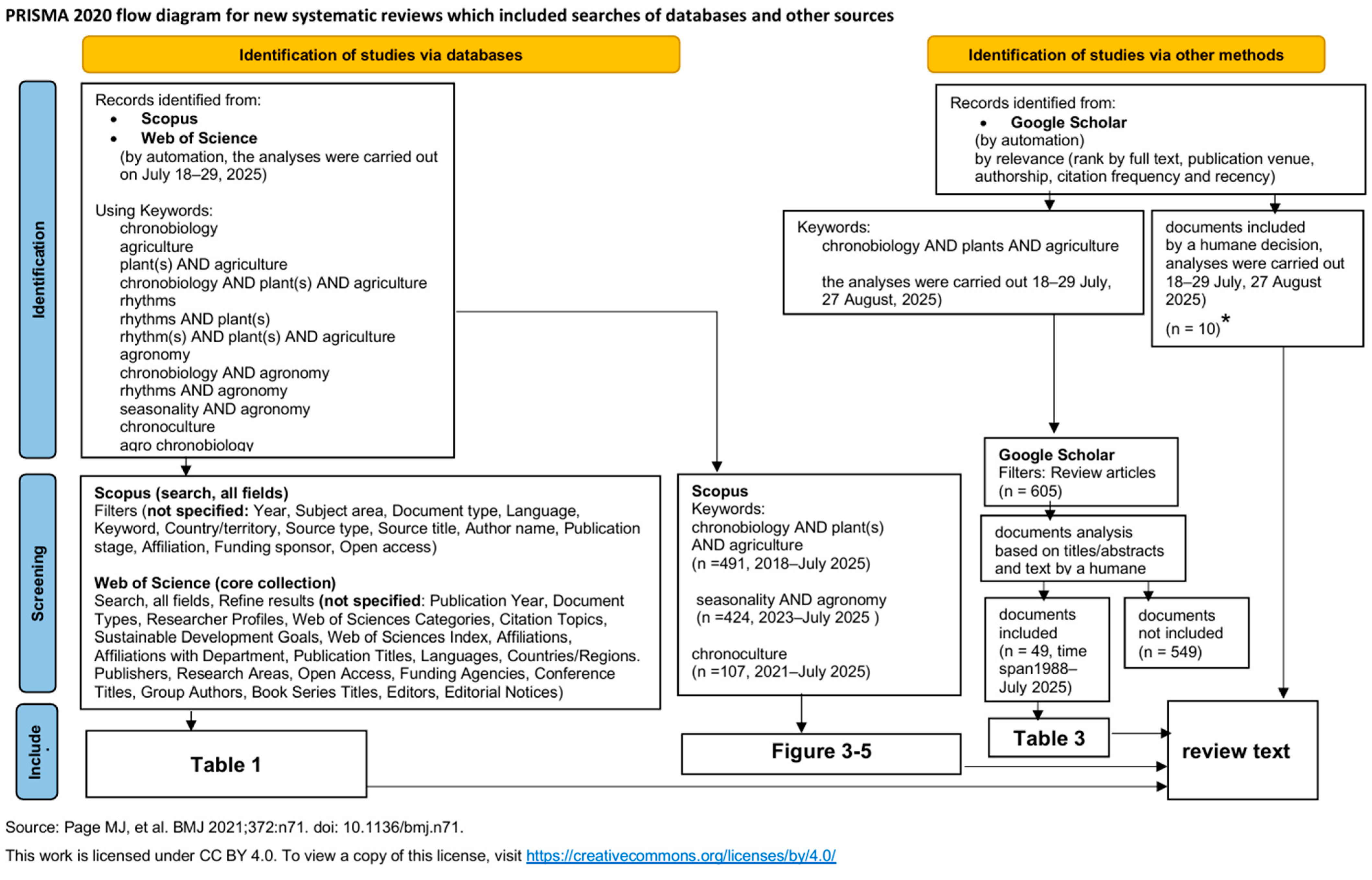
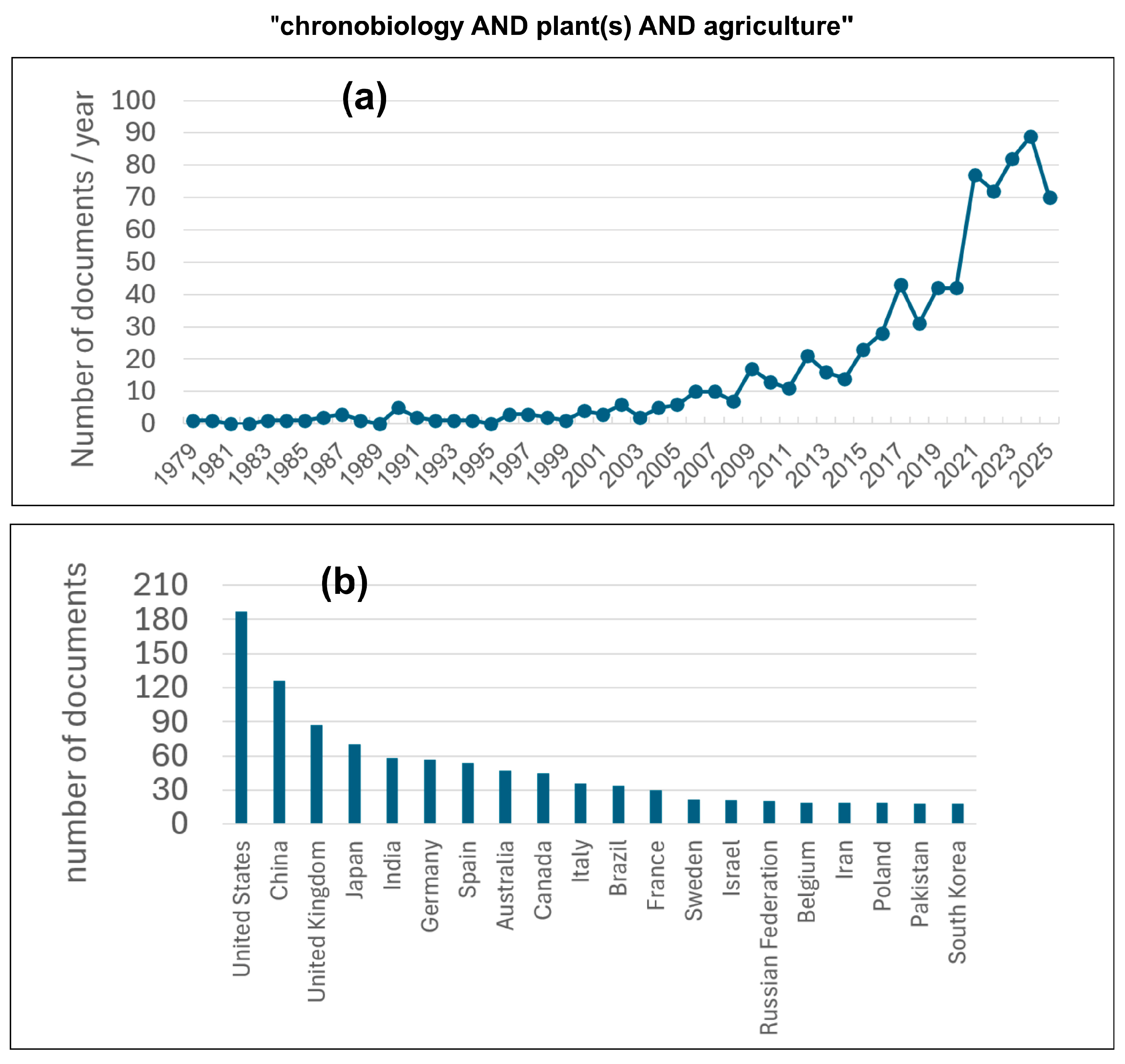

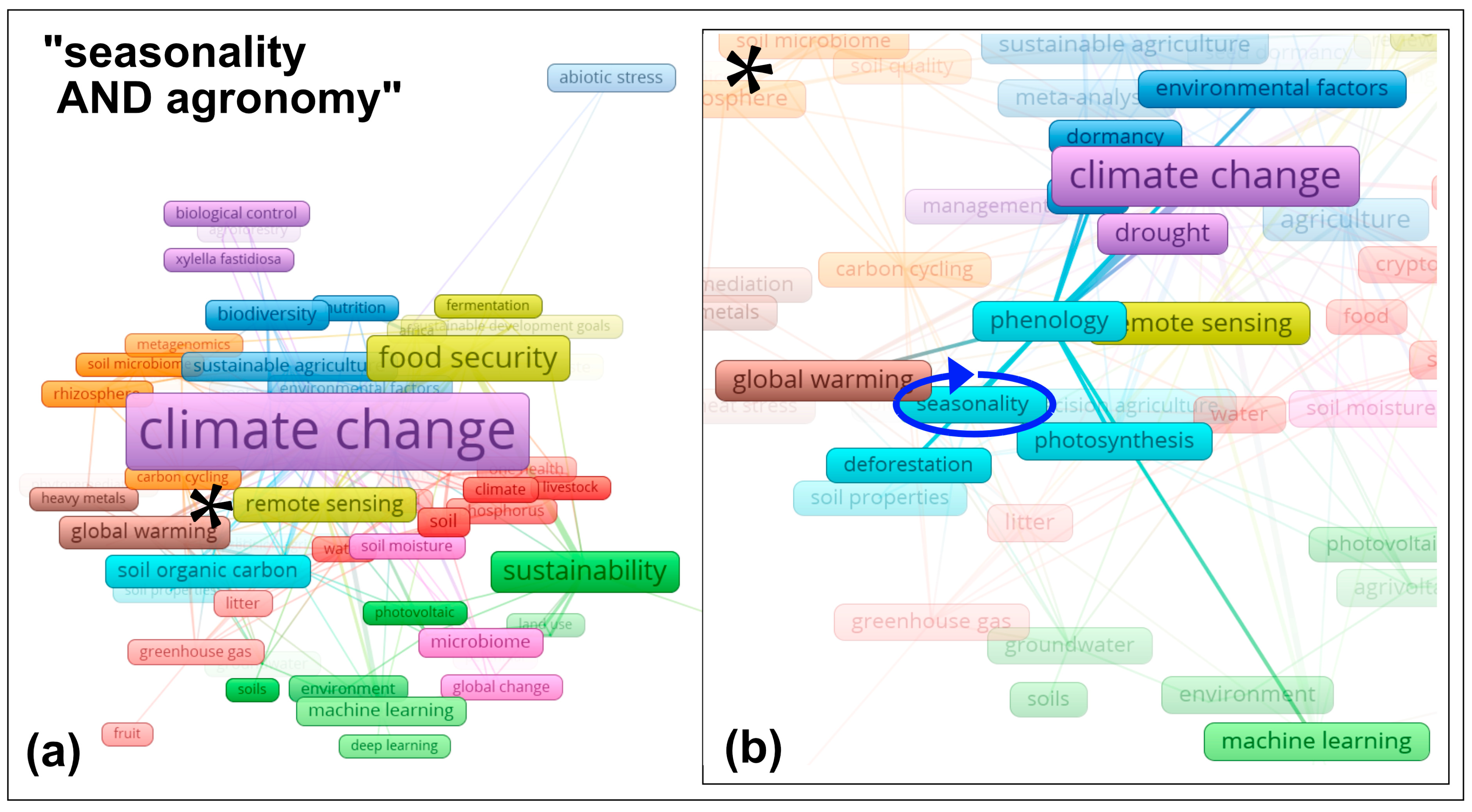
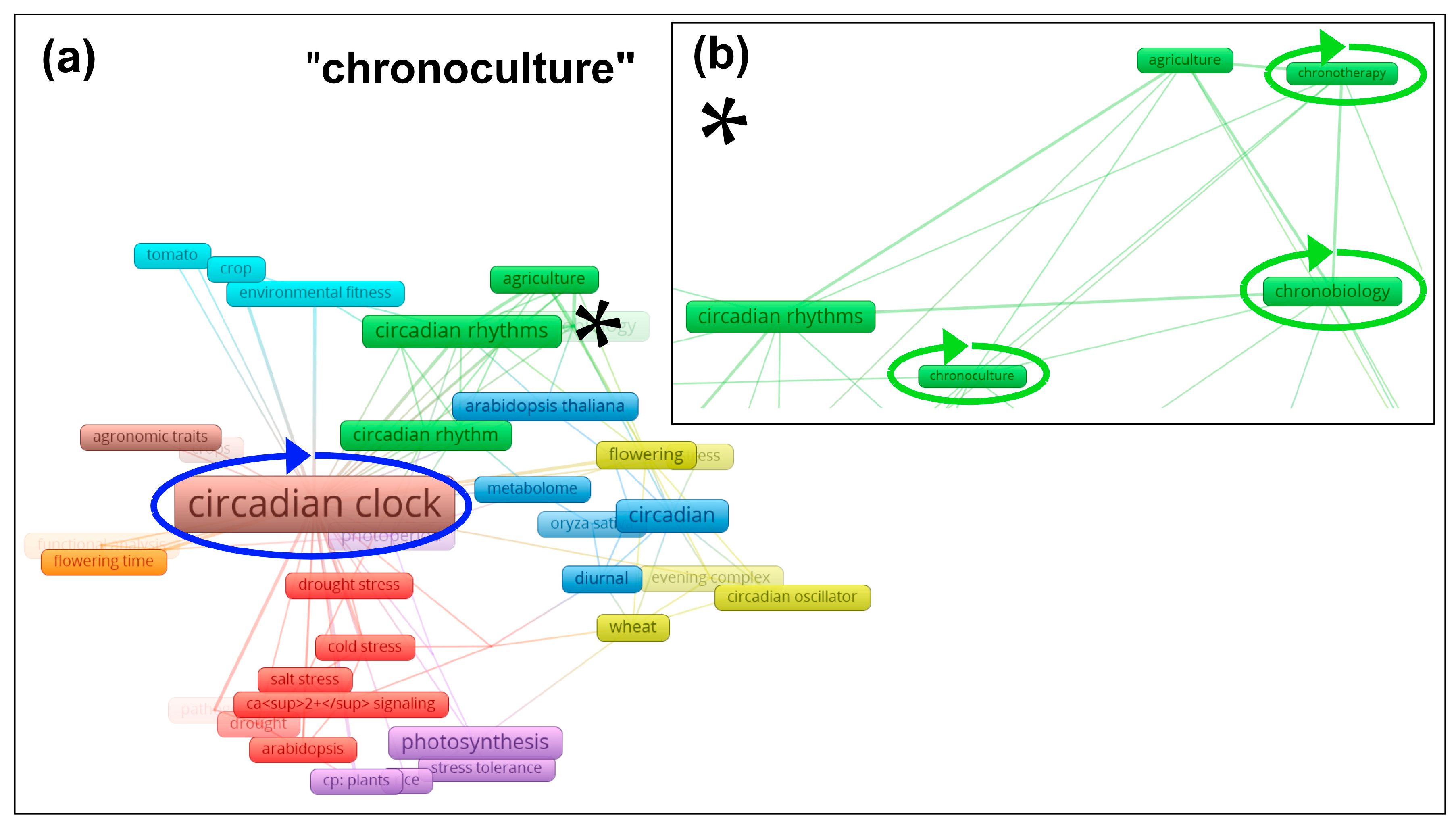
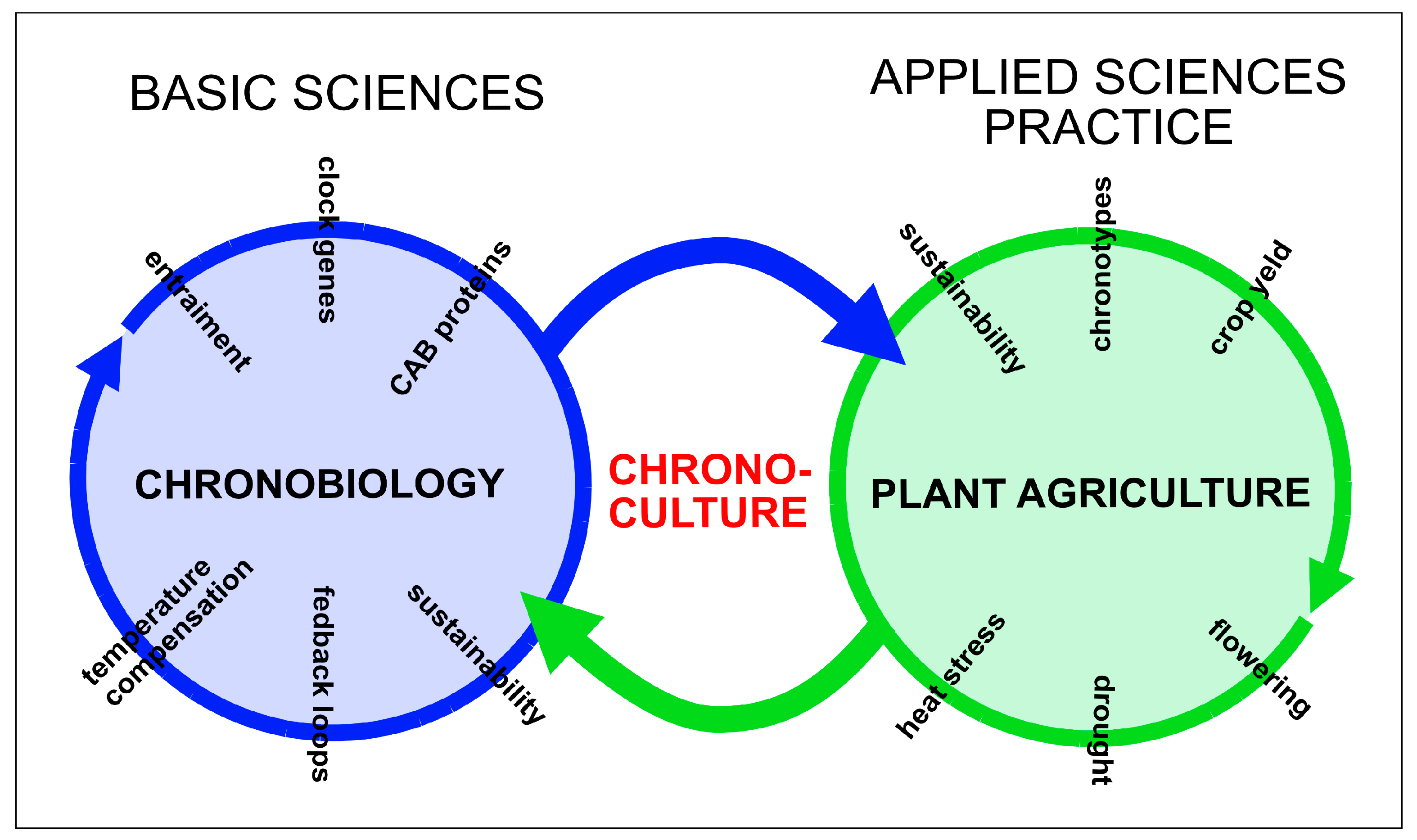
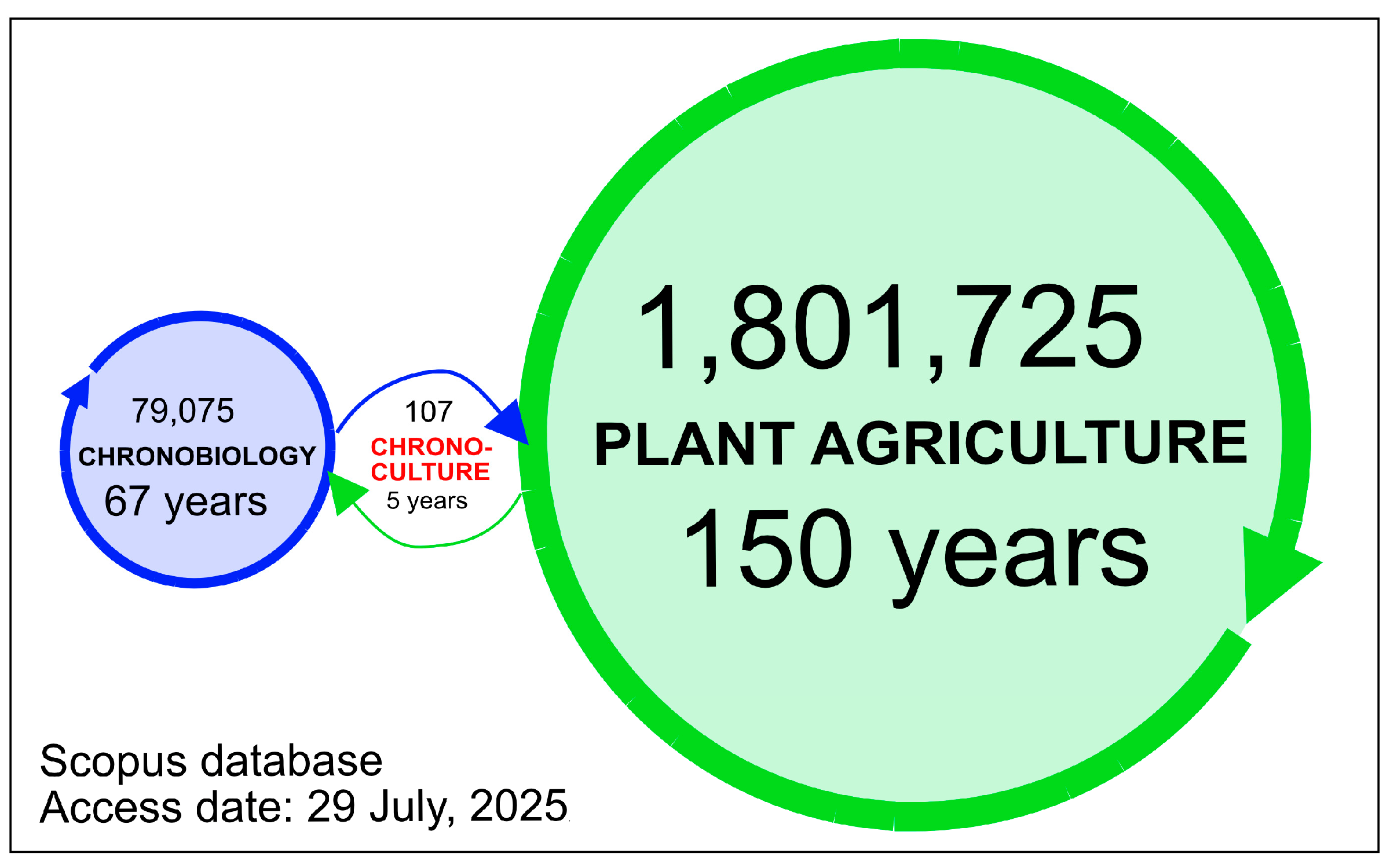
| Keywords | Number of Documents | |
|---|---|---|
| Scopus | Web of Science | |
| all documents | 82,400,000 (1788–present) * | 79,000,000 (1900–present) ** |
| chronobiology | 79,075 (1958–2025) | 7580 (1970–2025) |
| agriculture | 3,416,701 (1848–2026) | 2,644,651 (1899–2027) |
| plant(s) AND agriculture | 1,801,725 (1875–2026) | 594,441 (1900–2026) |
| chronobiology AND plant(s) AND agriculture | 760 (1979–2025) 491 documents (2018–2025) for Map 1 | 30 (1990–2025) |
| rhythms | 890,317 (1855–2026) | 192,366 (1924–2026) |
| rhythms AND plant(s) | 73,378 (1892–2026) | 6011 (1947–2025) |
| rhythm(s) AND plant(s) AND agriculture | 14,147 (1964–2026) | 1661 (1973–2025) |
| agronomy | 736,612 (1907–2026) | 63,928 (1940–2025) |
| chronobiology AND agronomy | 188 (1976–2025) | 2 (2018–2021) |
| rhythms AND agronomy | 4785 (1970–2025) | 41 (1977–2025) |
| seasonality AND agronomy | 11,352 (1977–2025) 424 review documents (2023–2025) for Map 2 | 89 (1963–2025) |
| chronoculture | 107 (2021–2025) for Map 3 | 4 (2021–2024) |
| agro chronobiology | 191 (1998–2025) | 3 (2019–2025) |
| References | Plant Chronobiology Findings | Plant Agriculture Problems | Field |
|---|---|---|---|
| [7,14,24,57] | ccg universal control key agricultural traits of plants (Figure 3 and Figure 5) | selection of plant species and variants for cultivation, domestication properties of genetic material selection of chronotypes so-called early and late varieties | GENETICS |
| [5,13,16,40,58,59,60] | biological clocks regulate fundamental plant physiological processes ultradian, diurnal, circadian infradian, seasons, annual rhythms | control of plant life cycle germination, growth, development and reproduction increase in yields | PHYSIOLOGY |
| [29,30,31,32,33,34,35,36,37,38,39] | melatonin (Figure 3) | oxidative stress stress protection | |
| [18] | photosynthesis circadian rhythm of CAB expression | photosynthetic efficiency crop yield | |
| [4] | circumnutation ultradian and circadian rhythms of growth and organ movements, “sun tracking” | crop climbing plants (Vitis vinifera, Phaseolus, Pisum, Humulus) plant lodging pollination (e.g., sunflower, buckwheat) mechanical harvesting of plants | |
| [15,41,61] | monitoring of natural seasonal and daily light rhythms, light-regulated circadian clock and its receptors, photoperiodism | use of appropriate intensity quality of light and photoperiod various light sources, oxygen stress | ENVIRONMENTAL SCIENCES |
| [17] | observation of periodic water availability rhythms of water uptake | water management and storage droughts, osmotic stress | |
| [9,18] | monitoring of natural seasonal and daily temperature rhythms, entrainment of circadian clock by temperature | plant temperature resistance heat stress | |
| [18] | nitrogen cycle, circadian-regulated nitrogen metabolism, crop rotation cycles | soil depletion, salt stress nitrogen fertilization | |
| [8,10,20,21,22,41] | seasons and daily rhythm of resistance to infection and pest and pathogen activity pest phototactic rhythm plant–animal interrelation | plant disease and pest control weed control flowering-pollination Apis mellifera | |
| [6,12] | rhythms of microbiomes of plants and soil | introduction of plant and soil microbiome to crop production | |
| [42,43] | daily rhythm of secondary metabolite synthesis | cultivation of herbs, medicinal plants | |
| [23,44,45,46,47,48] | phenology | seasonality of field work early or late spring autumn frosts sudden weather changes | |
| [25,26,27] | chrono-agro-informatics analyzing data from the environment and the plant and detecting cycles in the environment (e.g., precipitation or drought) and the plant growth rhythm algorithms for time series analysis | remote sensing and machine learning necessity for continuous monitoring of field and greenhouse crops using a variety of electronic sensors, monitoring of environmental factors, plant growth and health parameters using the internet of things, big data analysis, prediction of weather changes, frost, drought, rainfall | INFORMATICS |
| [2,3,18,40,49,57] | theoretical analyses of rhythmic fluctuations of the environment and the operation of the biological clock (detection of rhythms entrainment, oscillator models) | sustainable agriculture (Figure 5) | SUSTAINABILITY |
| Basic science investigation |  | Temporal Scale | Examples of Cultivation Operations | Expected Outcomes |
 | ultradian (hours) | irrigation scheduling (sub-daily cycles) greenhouse light/pH/temperature adjustments, fertigation pulses | improved resource-use efficiency reduced stress, optimized micro-environment | |
 | circadian (day–night) | sowing at optimal times of day diurnal pest control applications synchronization of pollination practices | higher crop vigor reduced pesticide use improved quality | |
 | infradian (weeks–months) seasonal/annual phenological phenomena | timing of sowing and harvesting crop rotation, seasonal irrigation regimes, application of growth regulators | optimized yield, resilience to climate variability sustainability of production |
Disclaimer/Publisher’s Note: The statements, opinions and data contained in all publications are solely those of the individual author(s) and contributor(s) and not of MDPI and/or the editor(s). MDPI and/or the editor(s) disclaim responsibility for any injury to people or property resulting from any ideas, methods, instructions or products referred to in the content. |
© 2025 by the author. Licensee MDPI, Basel, Switzerland. This article is an open access article distributed under the terms and conditions of the Creative Commons Attribution (CC BY) license (https://creativecommons.org/licenses/by/4.0/).
Share and Cite
Stolarz, M. Application of Chronobiology in Plant Agriculture. Appl. Sci. 2025, 15, 9614. https://doi.org/10.3390/app15179614
Stolarz M. Application of Chronobiology in Plant Agriculture. Applied Sciences. 2025; 15(17):9614. https://doi.org/10.3390/app15179614
Chicago/Turabian StyleStolarz, Maria. 2025. "Application of Chronobiology in Plant Agriculture" Applied Sciences 15, no. 17: 9614. https://doi.org/10.3390/app15179614
APA StyleStolarz, M. (2025). Application of Chronobiology in Plant Agriculture. Applied Sciences, 15(17), 9614. https://doi.org/10.3390/app15179614





